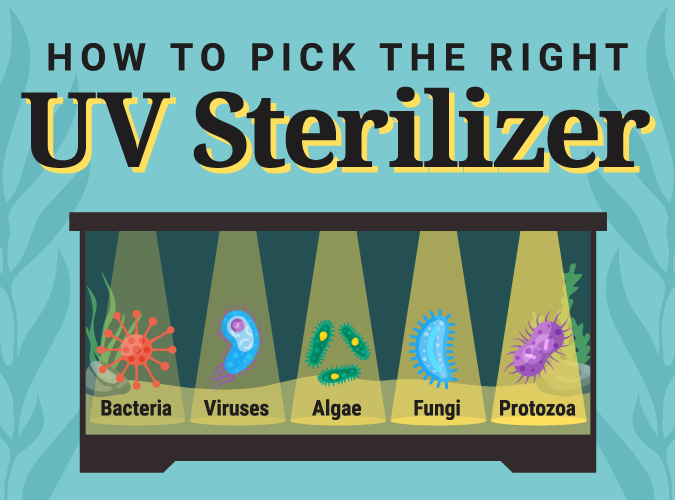A UV Sterilizer Solves Multiple Problems in Your Aquarium

If you own a home aquarium, there may come a time when you must combat various issues like algae, bacterial infections, and other nuisances. Wouldn’t it be nice if there were a way to prevent these problems entirely? Well, you may be in luck—a UV sterilizer helps avoid exactly these issues.
Read on to learn:
- What a UV sterilizer is
- How it combats excess algae and bacterial infections
- How to choose one that’s right for your tank
A UV sterilizer provides significant benefits, improving both the health and the aesthetic appeal of your home aquarium.

How Does a UV Sterilizer Work?
If you’ve ever been to a tanning salon, you’ve likely seen what a UV lamp looks like. You might be imagining that a UV sterilizer in an aquarium would look the same, casting an eerie blue light through the water. However, this isn’t always the case. The bulb may be enclosed in the sterilizer’s housing so you can’t see it from the outside.
A UV sterilizer is a component of your filtration system. You place it last in your filtration line, after your mechanical filter. Water then flows through the sterilizer and is exposed to ultraviolet light. The light sterilizes the water. This kills parasites, viruses, and algae, as well as any other microorganisms in the water.
It works by irradiating these microorganisms with light at a wavelength that mutates their DNA. This mutation makes them unable to reproduce. As a result, the growth and spread of infections are halted. Since it affects only free-floating microorganisms in the water that passes through the device, you don’t need to worry about your livestock.
These devices help sterilize liquids in all sorts of settings, from swimming pools to factories, and can be useful in your home aquarium. So, what are the benefits for your tank?

Getting rid of algae, bacteria, and other unwanted microorganisms in your tank helps fish thrive.
Devices Target Parasites and Bacteria
Many factors contribute to bacterial infections and parasites. Introducing new livestock is the most common cause. They can carry diseases or parasites you don’t know about, for example. Don’t properly quarantine them, and you can end up with an outbreak on your hands.
Another cause? Your livestock numbers reach a point that they become more susceptible to disease.
Either way, your home aquarium may be at risk. A UV sterilizer helps prevent this from occurring. Any free-floating parasite or bacteria in your home aquarium will flow through the UV sterilizer.
Since the process keeps prevents the organisms from reproducing, it halts the spread of these infections. In fact, your fish and other livestock avoid potentially expensive or even lethal health issues.
Keep in mind, however, that only the microorganisms that go through the device are affected. It has no residual effect and won’t kill parasites that have attached themselves to fish. This includes adult stages of ich, for example.
UV Sterilizers Kill Harmful Algae
In addition to bacteria and parasites, UV sterilizers kill algae, another kind of microorganism that gives aquarists trouble.
Algae are the aquatic microorganisms that form green slime on your aquarium surfaces. They cause your water to become murky. It’s natural for aquariums to have some algae, but excessive algae can impact the aesthetic appeal of your aquarium.
Algae can even affect the health of your fish, depending on the type of algae. Other factors include excess nutrients and high light levels.
By showering algae with ultraviolet rays, a UV sterilizer kills algae the same way it kills other microorganisms. Radiation prevents it from reproducing.
Because algae contribute so much to the turbidity of your water, killing free-floating algae dramatically improves your tank’s clarity. Install a UV sterilizer, and you’ll quickly notice how much clearer the water gets. Everything in your tank will be easy to see.
Your home aquarium can go from murky and greenish to clean and clear with minimal effort. This is especially true for beginners’ aquariums, which may have too many nutrients or too much light.
As noted above, the sterilizer works only on free-floating organisms. It won’t work on string algae and other species that attach themselves to rocks, substrate, fish, and other surfaces. Only microorganisms that flow to the device with the water will be affected by it.

Clear water in this aquarium showcases a variety of corals.
What Kind of UV Sterilizer Do I Need?
There are several things to consider when deciding to install a sterilizer. These include wattage, flow rate, and maintenance.
Sterilizer effectiveness depends on its ability to shower the microorganism with enough UV light. Different sizes and types need different amounts of radiation to kill them. These are as follows:
- Organism Killing Dose of UV light (Microwatt seconds per square centimeter)
- Viruses: 15,000
- Bacteria: 15,000 – 30,000
- Algae: 22,000 – 30,000
- Fungi: 45,000
- Protozoa: 90,000
Three factors affect the sterilizer’s performance: bulb strength, contact time, and UV penetration.
- Bulb Strength: The higher the bulb’s wattage, the more radiation it showers the microorganisms with. You’ll usually need to replace the bulbs twice a year to keep them working well.
- Contact Time: The more contact time microorganisms get with UV light, the more thoroughly it will kill them. This is affected by the sterilizer’s flow rate. A slower flow means it is exposed longer to UV light. Different microorganisms require different amounts of UV light to kill. As a result, they require different flow rates. Longer bulbs will also expose them to UV light longer, producing the same effect.
- UV Penetration: To kill the microorganisms in your home aquarium, the UV light has to be able to reach them. If the water is too turbid, UV light may not be able to penetrate effectively, for instance. This is why you place the sterilizer after the mechanical or biological filter. It’s also why it’s important to keep the lamp and sleeve clean. This keeps a film or mineral deposit from forming and blocking some of the light.
Let Us Help You Decide
Does a UV sterilizer sound like what you need to keep your tank clear and your livestock healthy? If you have questions about these and other solutions for improving your home aquarium in Crystal Lake, IL, in the Chicago area, give Living Art Aquatics a call at (847) 737-5151. Our experts have been creating aquatic seascapes for many years and are always ready to answer your questions!
Editor’s note: This blog was originally published on July 27, 2017, and was updated on June 11, 2019.



